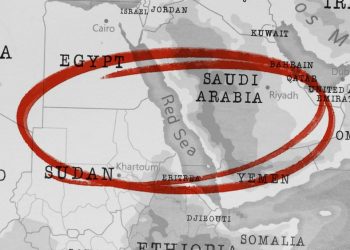An underwater mountain discovered
Survey ship HMS Echo has discovered an underwater mountain the size of the Rock of Gibraltar has she sailed through poorly-mapped waters in the Red Sea. The ship came across the huge feature while searching for volcanoes on the seabed – and also located a WW2 wreck off the Libyan coast as her 19-month deployment draws to a close.
This multi-coloured mound is an underwater mountain the size of the Rock of Gibraltar beneath the Red Sea – and until HMS Echo passed over the site, no-one knew it existed.
The hi-tech sonar suites of the Devonport-based survey ship mapped the huge feature for the first time, and it will now be marked on charts to prevent other seafarers running into it.
Echo was sent east of Suez at the beginning of last year to help improve charts of the region’s waters and gather key hydrographic data.
The enormous mound – the correct term is ‘sea mount’ is quite literally the biggest success of Echo’s deployment.
Yemeni fishermen evidently knew the mount existed – Echo found a dhow anchored on its summit as she carried out her survey of the area.
But existing charts of the area suggested the sea was 385 metres (1,263ft) deep – but over an eight-hour period, Echo collected reams of information with her sounders to prove otherwise.
After processing all that information, 24 hours later the powerful computers aboard the ship produced the stunning 3D imagery which revealed the true extent of the mount.
It rises to just 40 metres (131ft) below the surface of the Red Sea – deeper than the deepest draught of any civilian or military surface ship, but definitely a danger to submarines passing between the Mediterranean and the Middle East.
“We were actually looking for volcanoes – the southern Red Sea region has seen a significant amount of recent tectonic and volcanic activity with several volcanoes emerging from the sea close to the Yemeni coast line,” said Cdr Matt Syrett, Echo’s Commanding Officer.
“We didn’t find any. But we did find this. It is absolutely massive. And finding it is something which really makes everybody on board feel good.
“So often it’s difficult to show that what the Navy does has a tangible effect. This is visible proof. We found it and, as it’s a danger to other seafarers, it’s been reported to the United Kingdom Hydrographic Office and is expected to appear on new charts of the region in the near future.”
Now in the Mediterranean, Echo’s finds have continued – this time a dozen or so miles off Tripoli and possibly the wreck of a WW2 ‘Liberty Ship’.
This time the object stood 22 metres (72ft) proud of the seafloor, was 105 metres (344ft) long and 22 metres wide – or the length of 11 London buses parked in nine rows and stacked five deep… so not insubstantial.
Once again the UKHO – which provides charts for the Royal Navy, as well as many of the world’s merchant mariners – has been informed so other sea users can be warned of Echo’s discovery.
“From the shape of the hull and location of the superstructure it is likely to be an old Liberty Ship – and was most likely another casualty of World War 2,” said Cdr Syrett.
In the 18 months since Echo left UK waters she has carried out a wide range of essential survey tasking, from supporting assault ship HMS Albion during amphibious exercises in the Gulf last summer, to improving navigational safety for merchant shipping in the Gulf and Red Sea and carrying out oceanographic research off the Horn of Africa.
Source: Royal Navy






























































